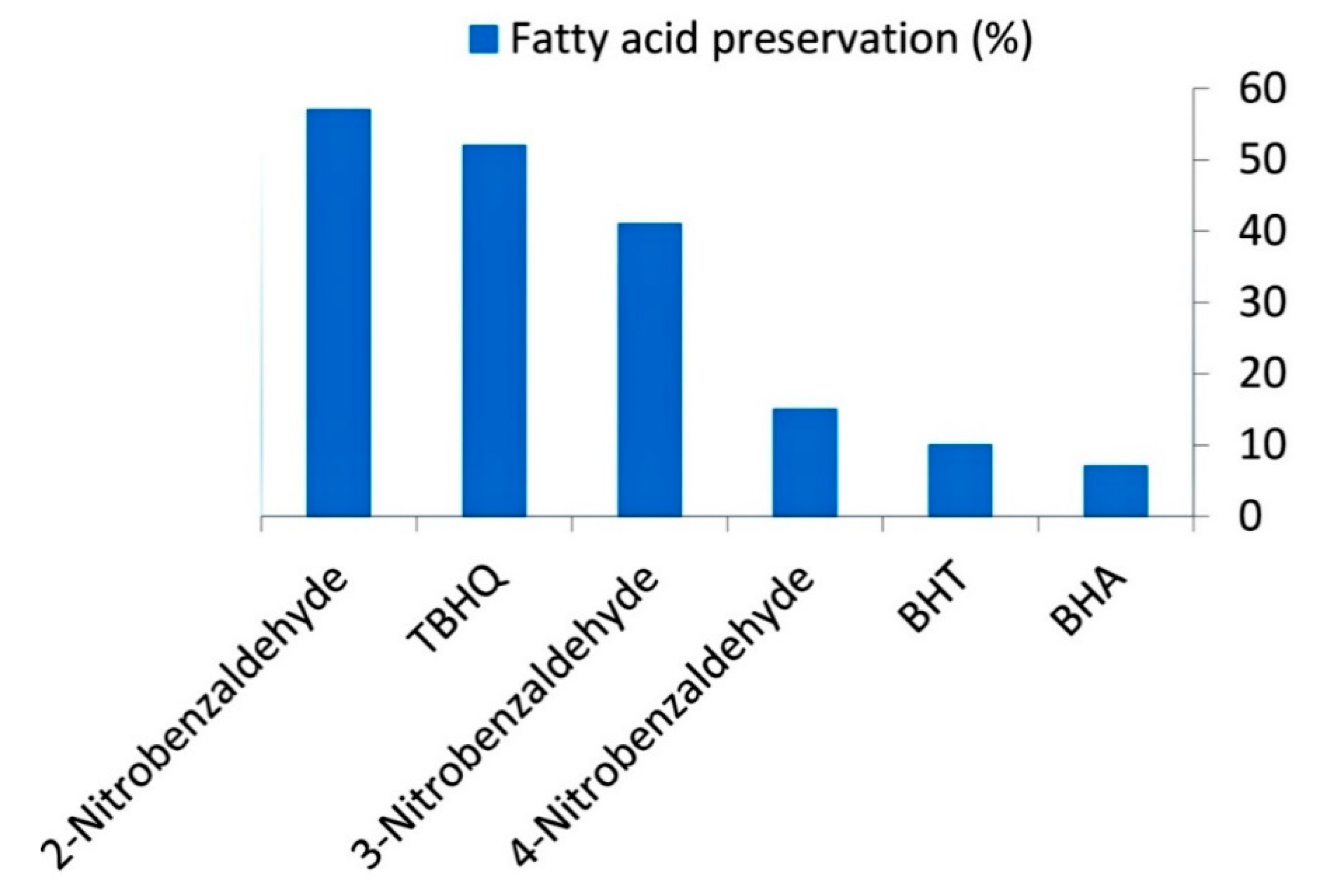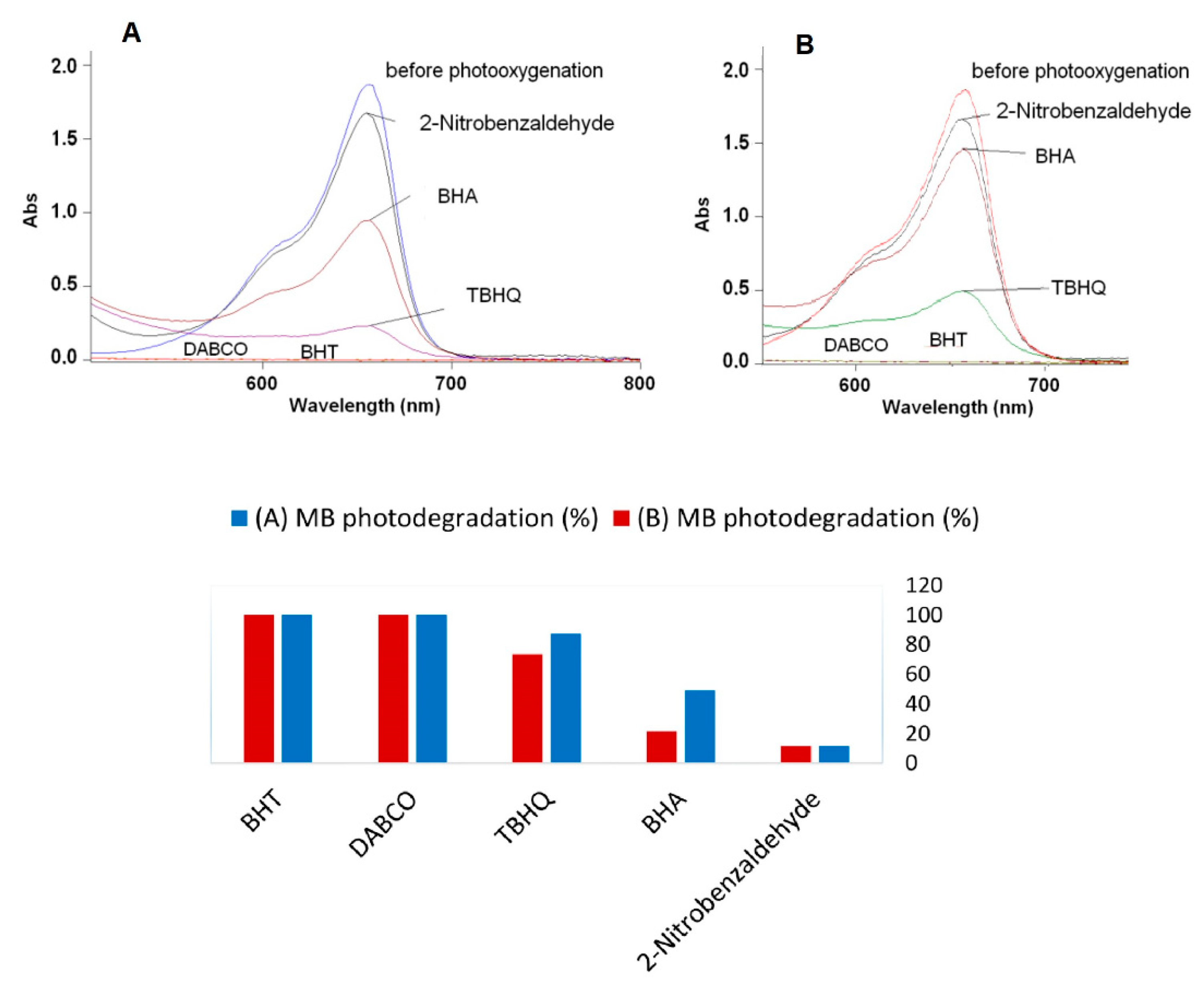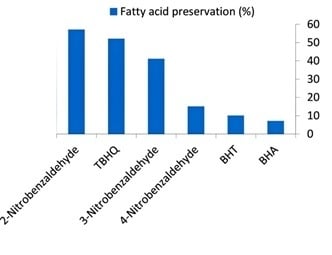Suppressing Effect of 2-Nitrobenzaldehyde on Singlet Oxygen Generation, Fatty Acid Photooxidation, and Dye-Sensitizer Degradation
Abstract
Highlights:
- 2-Nitrobenzaldehyde acts as a photostabilizing agent against oxidative stress
- Suppression of singlet oxygen-dependent damage of substrates demonstrated
- Photoprotection of fatty acids exceeding that of well-established antioxidants
- Stabilization against self-sensitization and bleaching of irradiated organic dyes
- Possible beneficial effects on tissues by inhibition of lipid peroxidation expected
1. Introduction
2. Materials and Methods
2.1. Material
2.2. Methods
2.2.1. Sample Preparation for Anthracene Oxidation
2.2.2. Sample Preparation for the Photooxidation of Fatty Acids
2.2.3. Sample Preparation for Degradation of Photosensitizers via Singlet Oxygen
3. Results and Discussion
3.1. Anthracene Photooxidation
3.2. Reaction of Fatty Acids with Singlet Oxygen
3.3. Photodegradation of MB
4. Conclusions
Supplementary Materials
Author Contributions
Funding
Acknowledgments
Conflicts of Interest
References
- Min, D.B.; Boff, J.M. Chemistry and reaction of singlet oxygen in foods. Compr. Rev. Food Sci. Food Saf. 2002, 1, 58–72. [Google Scholar] [CrossRef]
- Korytowski, W.; Schmitt, J.C.; Girotti, A.W. Surprising inability of singlet oxygen-generated hydroperoxycholesterol to induce damaging free radical lipid peroxidation in cell membranes. Photochem. Photobiol. 2010, 86, 747–751. [Google Scholar] [CrossRef] [PubMed]
- Baier, J.; Maisch, T.; Maier, M.; Engel, E.; Landthaler, M.; Bäumler, W. Singlet oxygen generation by UVA light exposure of endogenous photosensitizers. Biophys. J. 2006, 91, 1452–1459. [Google Scholar] [CrossRef] [PubMed]
- Smyk, B. Singlet oxygen autoxidation of vegetable oils: Evidences for lack of synergy between β-carotene and tocopherols. Food Chem. 2009, 182, 209–216. [Google Scholar] [CrossRef] [PubMed]
- Greer, A. Christopher Foote’s discovery of the role of singlet oxygen [1O2 (1Δg)] in photosensitized oxidation reactions. Acc. Chem. Res. 2006, 39, 797–804. [Google Scholar] [CrossRef] [PubMed]
- Girotti, A.W. Lipid hydroperoxide generation, turnover, and effector action in biological systems. J. Lipid Res. 1998, 39, 1529–1542. [Google Scholar] [PubMed]
- Kligman, L.H. Prevention and repair of photoaging: Sunscreens and retinoids. Cutis 1989, 43, 458–465. [Google Scholar] [PubMed]
- Pinnell, S. Cutaneous photodamage, oxidative stress, and topical antioxidant protection. J. Am. Acad. Dermatol. 2003, 48, 1–19. [Google Scholar] [CrossRef] [PubMed]
- Lengfelder, E.; Cadenas, E.; Sies, H. Effect of DABCO (1,4-diazabicyclo[2,2,2]-octane) on singlet oxygen monomol (1270 nm) and dimol (634 and 703 nm) emission. FEBS Lett. 1983, 164, 366–370. [Google Scholar] [CrossRef]
- Lee, J.H.; Jung, M.Y. Direct spectroscopic observation of singlet oxygen quenching and kinetic studies of physical and chemical singlet oxygen quenching rate constants of synthetic antioxidants (BHA, BHT, and TBHQ) in methanol. J. Food Sci. 2010, 75, C506–C513. [Google Scholar] [CrossRef] [PubMed]
- Ji, Y.; DiRocco, D.A.; Hong, C.M.; Wismer, M.K.; Reibarkh, M. Facile quantum yield determination via NMR actinometry. Org. Lett. 2018, 20, 2156–2159. [Google Scholar] [CrossRef] [PubMed]
- Lü, J.M.; Yao, Q.; Chen, C. 3,4-Dihydroxy-5-nitrobenzaldehyde (DHNB) is a potent inhibitor of xanthine oxidase: A potential therapeutic agent for treatment of hyperuricaemia and gout. Biochem. Pharmacol. 2013, 86, 1328–1337. [Google Scholar] [CrossRef] [PubMed]
- Groves, J.T.; Nemo, T.E.; Myers, R.S. Hydroxylation and epoxidation catalyzed by iron-porphine complexes. Oxygen transfer from iodosylbenzene. J. Am. Chem. Soc. 1979, 101, 1032–1033. [Google Scholar] [CrossRef]
- Lindsey, J.S.; Wagner, R.W. Investigation of the synthesis of ortho-substituted tetraphenylporphyrins. J. Org. Chem. 1989, 54, 828–836. [Google Scholar] [CrossRef]
- Aubry, J.; Pierlot, C.; Rigaudy, J.; Schmidt, R. Reversible binding of oxygen to aromatic compounds. Acc. Chem. Res. 2003, 36, 668–675. [Google Scholar] [CrossRef] [PubMed]
- Posavec, D.; Zabel, M.; Bogner, U.; Bernhardt, G.; Knör, G. Functionalized derivatives of 1,4-dimethylnaphthalene as precursors for biomedical applications: Synthesis, structures, spectroscopy and photochemical activation in the presence of dioxygen. Org. Biomol. Chem. 2012, 10, 7062–7069. [Google Scholar] [CrossRef] [PubMed]
- Šima, J.; Makáňová, J. Photochemistry of iron(III) complexes. Coord. Chem. Rev. 1997, 160, 161–189. [Google Scholar] [CrossRef]
- Hajimohammadi, M.; Schwarzinger, C.; Knör, G. Controlled multistep oxidation of alcohols and aldehydes to carboxylic acids using air, sunlight and a robust metalloporphyrin sensitizer with a pH-switchable photoreactivity. RSC Adv. 2012, 2, 3257–3260. [Google Scholar] [CrossRef]
- Bonnett, R. Photosensitizers of the porphyrin and phthalocyanine series for photodynamic therapy. Chem. Soc. Rev. 1995, 24, 19–33. [Google Scholar] [CrossRef]
- Henderson, B.W.; Dougherty, T.J. Photodynamic Therapy: Basic Principles and Clinical Applications; Marcel Dekker: New York, NY, USA, 1992. [Google Scholar]
- Moser, J.G. Photodynamic Tumor Therapy: 2nd and 3rd Generation Photosensitizers; Harwood: Amsterdam, The Netherlands, 1998. [Google Scholar]
- Sternberg, E.D.; Dolphin, D.; Brückner, C. Porphyrin-based photosensitizers for use in photodynamic therapy. Tetrahedron 1998, 54, 4151–4202. [Google Scholar] [CrossRef]
- Pandey, R.K.; Zheng, G. Porphyrins as photosensitizers in photodynamic therapy. In The Porphyrin Handbook; Kadish, K.M., Smith, K.M., Guilard, R., Eds.; Academic Press: New York, NY, USA, 2000; Volume 6, Chapter 43. [Google Scholar]
- Laimgruber, S.; Schmierer, T.; Gilch, P.; Kiewischb, K.; Neugebauer, J. The ketene intermediate in the photochemistry of ortho-nitrobenzaldehyde. Phys. Chem. Chem. Phys. 2008, 10, 3872–3882. [Google Scholar] [CrossRef] [PubMed]
- Sherwin, C.P.; Hynes, W.A. The metabolism on nitrobenzaldehydes and nitrophenylacetaldehyde. J. Biol. Chem. 1921, 47, 297–301. [Google Scholar]




| Entry | Reaction Conditions | Inhibition of Singlet Oxygen Generation (%) |
|---|---|---|
| 1 a | 2-nitrobenzaldehyde (0.002 mmol) + MB | 83 |
| 2 a | 2-nitrobenzaldehyde (0.001 mmol) + MB | 80 |
| 3 a | 2-nitrobenzaldehyde (0.0002 mmol) + MB | 71 |
| 4 b | 2-nitrobenzaldehyde (0.002 mmol) + H2TTP | 73 |
| 5 c | 2-nitrobenzaldehyde (0.002 mmol) + TTPFeCl | 26 |
| Entry | Condition | Fatty Acid Preservation (%) |
|---|---|---|
| 1 | Oleic acid + 2-nitrobenzaldehyde | 57 |
| 2 | Linoleic acid + 2-nitrobenzaldehyde | 54 |
| 3 | Oleic acid | 3 |
| 4 | Linoleic acid | Trace |
| 5 b | Oleic acid + 2-nitrobenzaldehyde | 51 |
| 6 c | Linoleic acid + 2-nitrobenzaldehyde | 23 |
| Entry | Reaction Condition a | MB Degradation (%) |
|---|---|---|
| 1 | 2-nitrobenzaldehyde (0.5 mmol) | 12 |
| 2 | 2-nitrobenzaldehyde (0.25 mmol) | 30 |
| 3 | 2-nitrobenzaldehyde (0.05 mmol) | 100 |
| 4 | 2-nitrobenzaldehyde (0.005 mmol) | 100 |
| 5 b | 2-nitrobenzaldehyde (0.5 mmol) | 23 |
| 6 c | 2-nitrobenzaldehyde (0.5 mmol) | 22 |
| 7 | 3-nitrobenzaldehyde (0.5 mmol) | 22 |
| 8 | 4-nitrobenzaldehyde (0.5 mmol) | 98 |
© 2018 by the authors. Licensee MDPI, Basel, Switzerland. This article is an open access article distributed under the terms and conditions of the Creative Commons Attribution (CC BY) license (http://creativecommons.org/licenses/by/4.0/).
Share and Cite
Hajimohammadi, M.; Vaziri Sereshk, A.; Schwarzinger, C.; Knör, G. Suppressing Effect of 2-Nitrobenzaldehyde on Singlet Oxygen Generation, Fatty Acid Photooxidation, and Dye-Sensitizer Degradation. Antioxidants 2018, 7, 194. https://doi.org/10.3390/antiox7120194
Hajimohammadi M, Vaziri Sereshk A, Schwarzinger C, Knör G. Suppressing Effect of 2-Nitrobenzaldehyde on Singlet Oxygen Generation, Fatty Acid Photooxidation, and Dye-Sensitizer Degradation. Antioxidants. 2018; 7(12):194. https://doi.org/10.3390/antiox7120194
Chicago/Turabian StyleHajimohammadi, Mahdi, Atena Vaziri Sereshk, Clemens Schwarzinger, and Günther Knör. 2018. "Suppressing Effect of 2-Nitrobenzaldehyde on Singlet Oxygen Generation, Fatty Acid Photooxidation, and Dye-Sensitizer Degradation" Antioxidants 7, no. 12: 194. https://doi.org/10.3390/antiox7120194
APA StyleHajimohammadi, M., Vaziri Sereshk, A., Schwarzinger, C., & Knör, G. (2018). Suppressing Effect of 2-Nitrobenzaldehyde on Singlet Oxygen Generation, Fatty Acid Photooxidation, and Dye-Sensitizer Degradation. Antioxidants, 7(12), 194. https://doi.org/10.3390/antiox7120194






